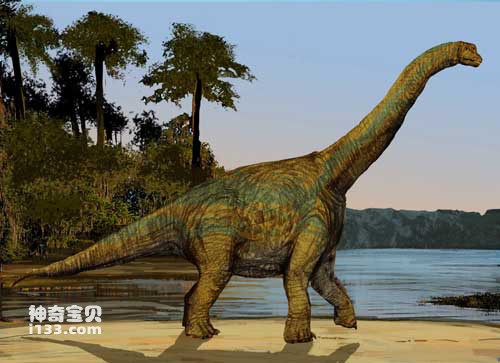Brachiosaurus is one of the large dinosaurs that lived in the Late Jurassic. It is 26 meters long, 12 to 16 meters high, and weighs 33 to 88 tons. Brachiosaurus's forelimbs were tall and much longer than its hind limbs, which helped it support the weight of its extra-long neck. A person's head could only reach the knees of this behemoth. Due to the hunched shoulders, the entire body of Brachiosaurus tilted back along the shoulders. This situation can still be seen in some tall animals such as giraffes today. There are 5 toes on each foot, and there are large claws on the inside of the front feet.
The shoulders of Brachiosaurus are about 5.8 meters above the ground, and when its head is raised, it is about 12 meters above the ground. Although it may feed on branches and leaves in high treetops, some paleontologists believe that it would not raise its head too high. For a long time - that would cause great difficulty in supplying blood to the head. The nostrils of Brachiosaurus, Apatosaurus, and Diplodocus all grow on the top of their heads. It is of course very easy for such tall animals to feed on branches and leaves on high trees.
Like other giant herbivorous dinosaurs, Brachiosaurus also has a long neck and a small head, and the mound-shaped protrusion on the top of its head is its nose. It has a huge body, a long neck, a small head and a long tail. A large, powerful heart continuously pumped blood from the Brachiosaurus's neck into its cerebellum. Some paleontologists believe it may have had several hearts to pump blood throughout its massive body. Along the cervical vertebrae, the well-developed muscles help support its head. Brachiosaurus eats young leaves on treetops that are out of reach of other herbivores. With its long neck, it can pick the highest leaves. The same is true for today's giraffes. Brachiosaurus had a well-developed jaw with 52 teeth with sharp spoon-like edges that could pinch off young branches and buds. Brachiosaurus needed to eat a lot of food to replenish the energy it needed to grow and move around in its massive body. An elephant can eat about 150 kilograms of food a day, and a brachiosaurus can eat about 1,500 kilograms a day, which is 10 times the amount of food consumed by today's giants! It may travel in groups every day, wandering across the endless savannah in search of fresh trees.
How was Brachiosaurus discovered? Riggs discovered the first Brachiosaurus fossils in 1900. In 1903, he named this dinosaur "Brachiosaurus", but the fossil was incomplete. In 1907, a German paleontologist went to Tanzania, Africa to prospect for minerals. While digging a pit with workers, he accidentally discovered a pile of huge animal bone fossils. The excavation took four years and a total of 250 tons of fossils were recovered. To move the fossils, paleontologists hired thousands of workers to transport them to the nearest port, where they were then shipped back to Germany. After research and sorting, several specimens were assembled. One of them is very complete. The assembled skeleton is 23 meters long and the head is more than 12 meters high from the ground. It is a Brachiosaurus. This huge skeletal fossil is currently on display in a German museum. Although it has experienced the flames of the two world wars, it has been successfully preserved and intact. Every year thousands of tourists come to see what is now the tallest and most complete dinosaur fossil in the world.

Chinese name: Brachiosaurus
Latin name: Brachiosaurus
Age of survival: Late Jurassic
Fossil origin: Colorado, Utah, Portugal, Tanzania
Physical characteristics: 26 meters long
Diet: plants
Species: Sauropod
Definition: long-armed lizard
animal tags: Brachiosaurus
We created this article in conjunction with AI technology, then made sure it was fact-checked and edited by a Animals Top editor.